Published in May 2022, this book from publisher Pen & Sword provides a photographic appreciation of trains on Western Region lines in the Black Country from the formation of the Western Region in 1948 to the demise of steam in 1967.
Written by Paul Dorney, the hardback book measures around 27.94 cm x 21.59 cm, has 144 pages, and 200 black and white photographs. It has a published price of £25.00 although Pen & Sword currently has it on offer at £18.75, and at the time of writing it can be obtained from Amazon for £18.38.
The title of Black Country Steam conjures up visions of lots of short freights tripping between yards and stopping passenger trains in this heavily-industrialised area. And that is what this book delivers, in plenty. Although there is no strict definition of what constitutes the Black Country, the area covered by the book, about 12 miles square in northwest Worcestershire and southeast Staffordshire, is a good approximation.
Many will agree that there is not much glamour in the trains that could be photographed in the area, but the author has produced a book that superbly illustrates scenes depicting railways in the grimy industrial landscape. All of the photographs are accompanied by informative captions that describe not only the train or station in the photo but an extended description of the locality or train workings.
Divided into chapters covering the individual lines and branches and each with an informative introduction, the book covers each of the areas former Western Region’s lines, supported by a very useful map n the foreword. Starting with The West Midland Line and moving clockwise, the author visits Stourbridge, the Stourbridge to Wolverhampton line, Dudley, Wolverhampton, the Wombourn Branch, the Priestfield to Birmingham and Smethwick to Stourbridge lines, the Halesowen and Windmill Hill Branches. Within the area there were a number of surprisingly steep inclines, where even short freight trains often required bankers, and these are depicted in a chapter titled Assisting Engines.
Because of the region’s relative lack of attractions for railway photographers, the author has done well to collate photographs illustrating all stations in the area. Freight traffic dominated the area, and the book provides a superb appreciation, illustrating the wide variety of locomotive power used to haul the variety of traffic generated by local industry, the sidings and yards that served it, as well as the engine sheds and maintenance facilities that kept the locos running.
As well as freight trains, some passenger trains required the use of assisting engines, such as the train on the left below which shows a 5101 Class Prairie tank assisting a Hall away from Stourbridge Junction. On the right is a classic Black Country scene, with an 0-6-2 tank engine at the head of a train of empty wagons.
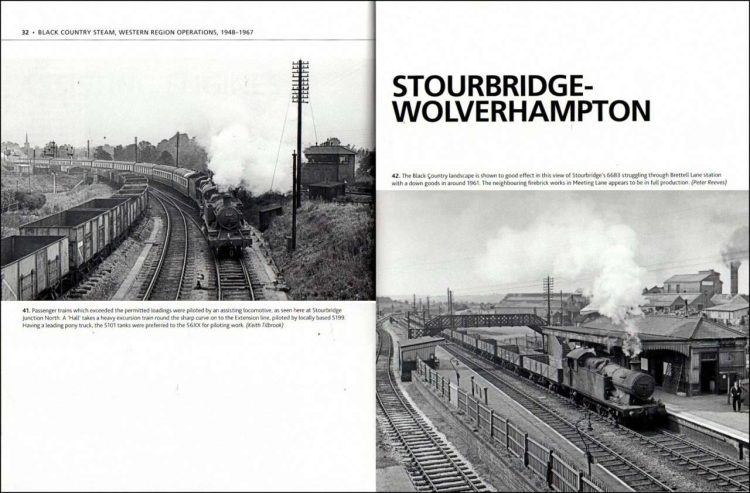
The pages below capture scenes that were once commonplace around the Black Country, with an auto-train from Wolverhampton on the left, a pannier tank hauling a freight train at the top right, and at the bottom right an extensive layout of sidings in a goods yard.
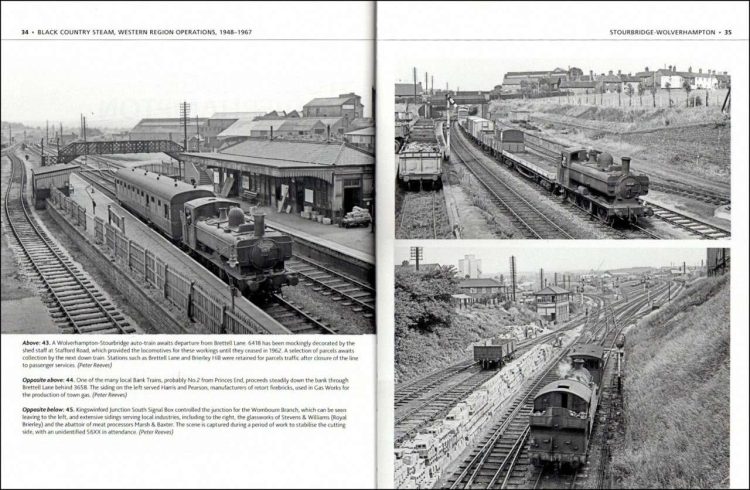
The variety of trains that could be seen in the Black Country is neatly summarised in the pages below of the now-closed Wolverhampton Low Level. The left-hand page shows 0-6-0 pannier tanks on parcel trains, whilst at the top right, another pannier tank is on shunting duty. In contrast, at the bottom right Castle Class No. 7032 Denbigh Castle prepares for a service to Paddington.
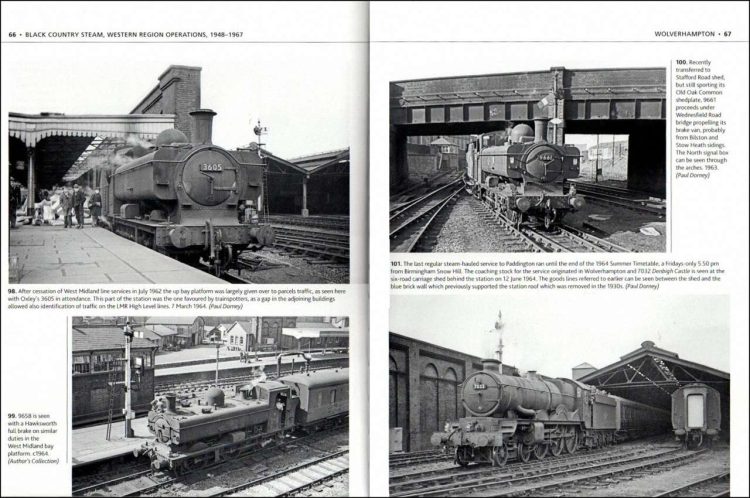
Steam engines required regular maintenance, which the author has captured superbly in the photos below. On the left are scenes at Wolverhampton Works, which was the Western Region’s largest overhaul facility after Swindon Works, whilst on the right are scenes from Oxley engine shed, which was one of two sheds in Wolverhampton and mainly supplied freight and shunting engines, whereas Wolverhampton’s other shed, at Stafford Road, was home for main line express and suburban passenger tank engines.
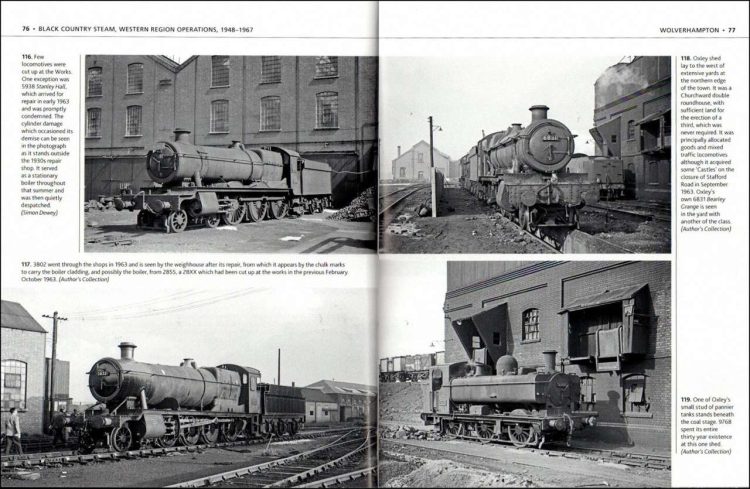
These photos of the Wombourn branch illustrate well its steep nature. Top left is Grange Class No. 6854 Roundhill Grange struggling against the adverse gradient, as is 0-6-0 pannier tank No. 8718 at the top right. The bottom photos show more typical Black Country scenes, with on the left a train of box vans being tripped by yet another pannier tank, while at the bottom right is a loaded coal train on the final stage of its journey.
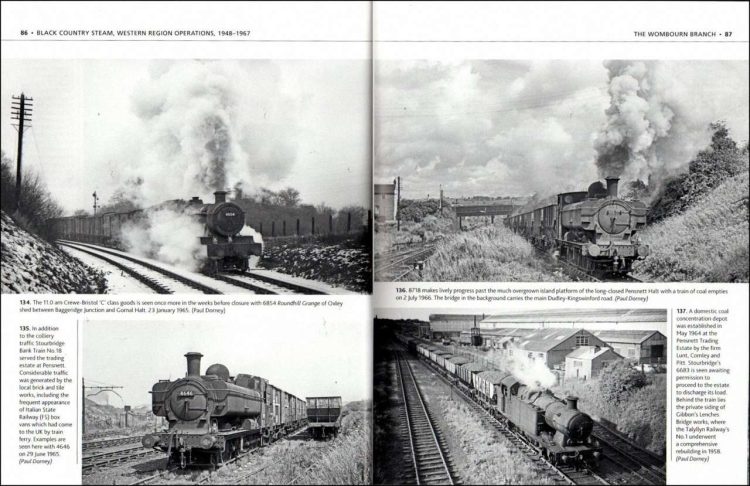
Although strictly speaking Birmingham Snow Hill is outside the accepted limits of the Black Country, the inclusion of the photos below belies the impression that all Western Region trains in the area were trip freight workings or stopping passengers trains. On the left, Castle Class 7026 Tenby Castle departs from the station, while at the top-right King Class 6005 King George II arrives from Wolverhampton, and at the bottom right Hall Class 5958 Knolton Hall waits to depart on an express for Swansea.
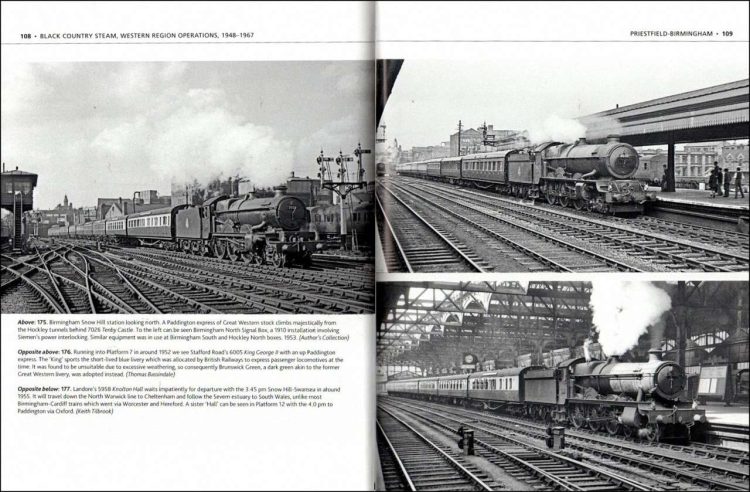
In summary, this is an excellent photographic record of trains on the Western Region in the Black Country. With many less-glamorous and long-lost locations, good coverage of trip workings and freight trains and largely-vanished industrial backgrounds, the book provides a good appreciation of the region as it was. The quality of the volume is enhanced by the excellent reproduction of generously-sized photographs. A good map of the area provides a very useful addition to enhance the reader’s understanding of the area. A must-have book that covers the industrial heart of the Black Country and is highly recommended.
The book is available to purchase from Amazon and from Pen & Sword.
We would like to thank Pen & Sword for providing RailAdvent with a copy of the book for review.






Responses